 (Colorado Chess Informant – January 2009)
(Colorado Chess Informant – January 2009)
BY NM TODD BARDWICK
There are so many different types of imbalances that can occur in chess that it is difficult to have specific knowledge about everything. When you find yourself in one you haven’t studied, it is best to break the position into chunks you do understand, and then add in the other aspects of the position.
This situation arose in my 4th round game of the 1995 Colorado Open against SM David Gliksman (Lucky) when we exchanged down into a rook and knight vs. rook endgame. (See the article, “A Long Day’s Journey into Knight,” in the January 1996 CSCA Informant or in the Articles Section under CSCA Informant on www.ColoradoMasterChess.com).
This twelve-hour game holds the Colorado record for the longest game between masters and is unofficially the longest continuous game (without an adjournment) between masters in United States (according to a couple of older GM columnists I consulted).
The game started at 5:00 p.m. on Sunday, September 5, 1995, and seven hours later, around midnight, we ended up with a rook and knight vs. rook endgame. As the last pawn was captured, I starred the move on my score sheet and started the 50-move count.
In most cases the R+N vs. R is a theoretical draw, but the strong side has virtually no losing chances and there are plenty of opportunities for the weak side to go wrong.
Half a dozen years or so before this game, David drew the R vs. R+N endgame against GM Christiansen in the American Open in Los Angeles. Christiansen didn’t press too hard to win as he had another game scheduled to play an hour later. David was also familiar with a game earlier that year where GM Walter Browne won a R+N vs. R endgame against SM Thomas Wolski in a sudden death time control. The ending is difficult for the weak side, but theoretically drawable. David chose to test my endgame play (and endurance!)…as world-class players have lost this endgame.
More recently, Game 4 of the 2000 World Championship Match between Kasparov and Kramnik also resulted in a R vs. R+N endgame which was drawn, with Kramnik on the strong side with the knight.
Since I had never studied this particular ending, I tried to figure out whether or not I had practical drawing chances in it back when there were more pieces and pawns left of the board. Often the best way to figure out a position you don’t understand is to start with something you do know, and work backwards from there. Of course, if I was to lose, the basic checkmate position with a rook would look something like this:
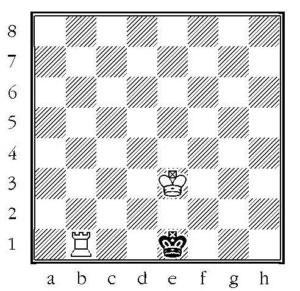
Black still has a rook and White has a knight to add to the board. Black, of course, doesn’t want to get checkmated, so his rook would try to perpetually check the White king as Black closed in on a mating position. White would have to interpose his knight to avoid the annoying checks. Adding these pieces, the basic position before potential mate might look something like this:

Observe that the knight attacks both d2 and f2, squares already covered by the White king. Notice the knight only acts as a shield in this case, and doesn’t take away more flight squares, like perhaps a bishop would (a bishop on e4 would also attack c2 and g2 making it more difficult for the Black king to escape). Black doesn’t want to allow Rb1 mate, so he could run his king to d1 or f1 to escape the back rank mate.
A couple other keys to the position for Black are to try to avoid moving his king into the corner, try to keep his rook as far away from his king as possible so as to avoid knight forks, and try to keep flexibility in his rook’s position so that he check from either ranks or files, whichever is best at a given moment.
If you want to delve into this type of endgame in painful detail, a good source is “Secrets of Pawnless Endings” by John Nunn.
Below is the R+N vs. R endgame between David and myself and then same endgame where both GMs Judith Polgar and Alexander Onischuk both failed to hold the draw.
David Gliksman (Lucky) (2459) – Todd Bardwick (2210), Colorado Open, 9/3-4/1995
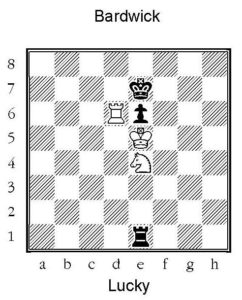
93.Rxe6+ (The last pawn is captured. This is where I put a star on my score sheet and started the 50-move draw count.) 93…Kd7 94.Rh6 Kc7 95.Kd5 Rd1+ 96.Kc4 Kd7 97.Rg6 Ke7 98.Ra6 Kf7 99.Nc3 Rd2 100.Nd5 Rd1 101.Rd6 Kg7 102.Kc5 Rd2 103.Re6 Kf7 104.Kd6 Rd1 105.Re2 Kg6 106.Ke6 Rg1 107.Nf4+ Kg7 108.Ke7 Rg4 109.Re4 Rg1 110.Re6 Rg5 111.Rf6 Ra5 112.Rg6+ Kh7 113.Rg4 Ra7+ 114.Kf6 Ra6+ 115.Ne6 Rb6 (This is similar to generic positions I saw in my mind explained above. I decided on a strategy to keep the knight pinned to the king as long as possible so it can’t help to form a mating net around my king. If the White king breaks the pin, Black will try to perpetual check with the rook. Black tries to burn moves off the 50-move count by annoying the White king as much as possible.)
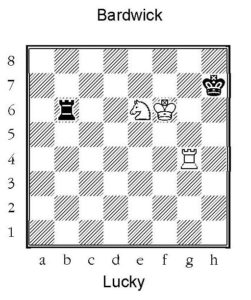
116.Rh4+ Kg8 117.Ra4 Kh7 118.Ra8 Rd6 119.Ra1 Rb6 (Fortunately for Black, he has one square available to avoid mate.) 120.Ra2 Rd6 121.Rh2+ Kg8 122.Rh6 Ra6 (Again, keeping the knight pinned so as to limit White’s choices.) 123.Kf5 Ra5+ 124.Kg6 Ra6 125.Kh5 Ra1 (Giving Black the option of checking from a different direction.) 126.Rf6 Rh1+ 127.Kg6 Rg1+ 128.Ng5 Rg2 (A similar position as occurred on move 115. This position is rotated 90 degrees with the knight pinned one file from the edge of the board instead of 2 files. Hopefully, this won’t change anything!) 129.Re6 Kf8 130.Re1 Rg4 131.Re3 Rg1 132.Kf6 Rf1+ 133.Nf3 Ra1 134.Nd4 Rf1+ 135.Nf5 Rf2 (We have seen this position’s cousin before!) 136.Ra3 Ke8 137.Rd3 Rf1 138.Rd2 Rf4 139.Ke5 Rf1 140.Nd6+ Ke7 141.Ra2 Re1+ 142.Ne4 Kf7 143.Ra7+ Kg6 Draw!
Judith Polgar (2675) – Garry Kasparov (2775), Dos Hermanas, 1996
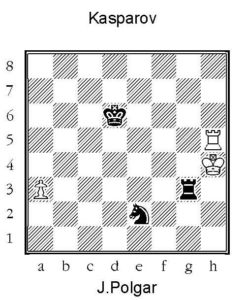
59…Rxa3 (Starting the 50-move draw count.) 60.Kg4 Ke6 61.Rb5 Rg3+ (Forcing the White king against the edge of the board.) 62.Kh4 Rg1 63.Rg5 Rf1 64.Ra5 Kf6 65.Ra8 Rg1 66.Rf8+ (66.Ra6+ Kf5 67.Ra5+ Ke4 68.Ra4+ Nd4 draws Black’s king away from White’s king.) 66…Ke5 67.Re8+ Kf4 68.Rf8+ Ke4 69.Re8+ Kf3 70.Kh5 (White runs away from the Black king. 70.Rf8+?? loses to 70…Nf4 and 71…Rg4 mate!) 70…Ng3+ 71.Kh6 (71.Kg5 or 71.Kg6 don’t keep the king off the h-file for long as 72.Ne4+ and the threat of 73.Nd6+ would fork the king and rook with the knight.) 71…Nf5+ 72.Kh7 Kf4 73.Rb8 Rg7+ (Forcing White’s king into the corner.) 74.Kh8 Rd7 75.Re8 (75.Rb1 Kg5 76.Rg1+ Kf6 77.Rf1 is similar to the defense I used against David.) 75…Kg5 76.Re6 Nd4 77.Re1 Kf6 78.Rd1 Rd5 79.Ra1 Ne6 80.Ra6 Kf7 81.Ra7+ Kg6
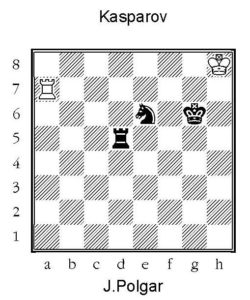
82.Ra8 (Forced to avoid mate. White would prefer to have her rook in a more active location to annoy and check the Black king. White should still be drawing, but there are greater odds for disaster with the more passively placed rook.) 82…Rd7 83.Rb8 Rc7 84.Kg8 Rc5 85.Ra8 (The rook can’t leave the back rank because of mate.) 85…Rb5 86.Kh8 Rb7 87.Rc8 Nc7 88.Rg8+ Kh6 89.Rg1?? (Losing by force. 89.Rc8 seems a reasonable way to hold on. White only needs to survive and keep doing what is working…the burden of proof is on Black to find a way to win.) 89…Rb8+ 90.Rg8 Ne8! 91.Resigns (If 91.Rf8 Kg6 92.Rg8+ Kf7 and if 93.Kh7 Nf6+ or 93.R moves down g-file, 93…Ng7 mate or 93…Nf6+ 94.Rg8 Rxg8 mate.)
Alexander Onischuk (2670) – Leinier Dominguez (2708), Biel, 2008
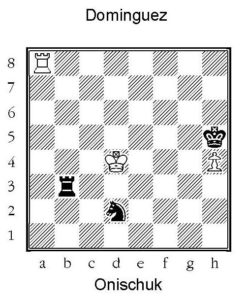
53…Kxh4 (The last capture was just made and the 50-move count begins. The position is theoretically drawn. White, of course, wants to keep his king in the center of the board as long as he can. Cuban GM Leinier Dominguez plays on, testing Onischuk’s ability to play the endgame perfectly.) 54.Rg8 Nf3+ 55.Kc4 Rb1 56.Kd5 Ng5 57.Ke5 Kg4 58.Kd4 Rd1+ 59.Ke5 Re1+ 60.Kd5 Re7 61.Kd4 Kf5 62.Rf8+ Nf7 63.Ra8 Kf4 64.Rf8 Rd7+ 65.Kc5 Ke4 66.Ra8 Rc7+ 67.Kb4 Kd4 68.Kb3 Ne5 69.Rd8+ Nd7 70.Kb2 Kd3 71.Rh8 (It is important that White rook can flexibly check from either direction.) 71…Rb7+ 72.Kc1 Nc5 73.Rh3+ Kd4 74.Kc2 Rc7 75.Rh4+ Ne4+ 76.Kb3 Rc8 77.Kb2 Rg8 78.Kb3 Rg2 79.Kb4 Rb2+ 80.Ka3 Rb8 81.Ka4 Kd5 82.Ka3 Nc5 83.Ka2 Ne6 84.Ka3 Nd4 85.Rh7 Rb6 86.Ka2 Kc4 87.Rc7+ Kd3
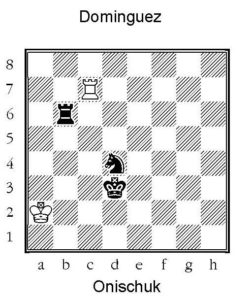
So far Onischuk has handled the position flawlessly for 34 of the 50 moves. Now comes the catastrophe: Onischuk should now play 88.Rh7 and resume checking from the h-file, but he plays 88.Rd7?? Kc2! (The knight can’t be taken because of mate in 2!) 89.Ka3 (89.Ra7 Rb2+ 90.Ka3 Nb5+ or 90.Ka1 Nb3 mate.) 89…Nc6 90.Ka4 Rb4+ (Forcing White’s king back toward Black’s king.) 91.Ka3 Rb5 0-1 (The Black knight skillfully controls the b4 square, protects a5 for the rook, prevents 91.Ra7, and clogs up the c-file from rook checks!)
